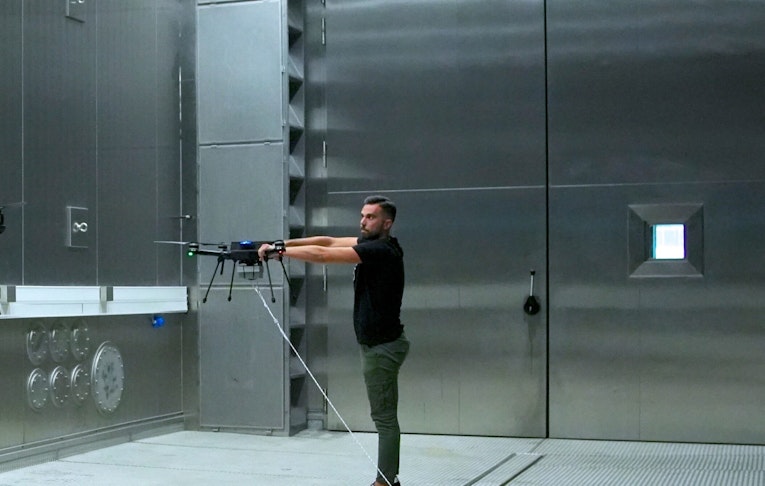Up to 9,000 m.a.s.l: first free-flight drone tests in the Large Cube
Over the past few days, two types of MAVTechhttps://www.mavtech.eu/ company drones have been put through their paces to test their usability in high-altitude, complex alpine environments in the terraXcubehttps://terraxcube.eurac.edu/ . It was the first time our Large Cube was used to test drones in free flight.
 © MAVTech / BF Visuals
© MAVTech / BF VisualsThe test presented certain complex challenges that required both technical expediency and skill on the part of the pilot who had to maneuver the meter-wide/long aircraft in an enclosed environment. The company, which has one of its offices at NOI Techpark in Bolzano, uses their drones in a variety of civilian applications such as precision agriculture, monitoring in riverine settings, and search and rescue in alpine environments. Recently tests have been carried out within the framework of the BLUESLEMON project to investigate the possibility of using drones to monitor active landslides. The project brings together MAVTech, the FOS Group and Eurac Research and is funded by the Autonomous Province of Bolzano.
Conducting free flight tests – up to 9,000 m.a.s.l
For drone flights, the alpine environment is certainly complex. In addition to extreme weather and climates, the altitude is the biggest obstacle: thinner air decreases the buoyancy of drones-drones that in these scenarios carry significant loads and weights such as thermal imaging cameras and remote sensing devices such as LIDAR technologies.
To meet the challenges of altitude, MAVTech’s custom-made drones mounted higher-performance and more efficient propellers and engines. These conditions were recreated in the terraXcube where two models including one of the latest generation were tested. The drones were tested at a variety of altitudes, from that of Bolzano up to 9,000 m.a.s.l. In this extraordinary context, MAVTech’s latest generation model showed excellent efficiency even with loads of up to 4 kg. The test also gave valuable insights on how to continue to improve the aircraft.
The free-flight test
What’s unusual about this test is that until now, free flight had not been attempted in the Large Cube. Before, drones were flown whilst they were tethered to a safety lanyard within the chamber. “In the past for similar tests, drones were constrained to a load cell,” explains Riccardo Parin, terraXcube researcher and head of the experiment, “so the drone was prevented from flying and was stuck to this sort of cube that measured its thrust and other parameters.” After the initial tests an incremental approach was used to measure drone efficacy. As is typical of aeronautical tests the difficulty of the experiment was gradually increased until the free-flight height of 9000 m.a.s.l was reached.
“Flying indoors is very complicated and, moreover there is no GPS signal inside the terraXcube, this means the flight had to be completely undertaken in manual mode. For this reason a camera was used for positioning instead of GPS,” adds Gianluca Ristorto, aerospace engineer at MAVTech.
The collaboration between terraXcube and MAVTech will continue in the coming months: among the next trials will be to test the automatic delivery of defibrillators by drone.
In order to give you a better service this site uses technical cookies. Additionally third party cookies are used for embedded content. If you decline, you will not see content from third parties (such as Youtube videos or Facebook/Twitter content). Privacy policy